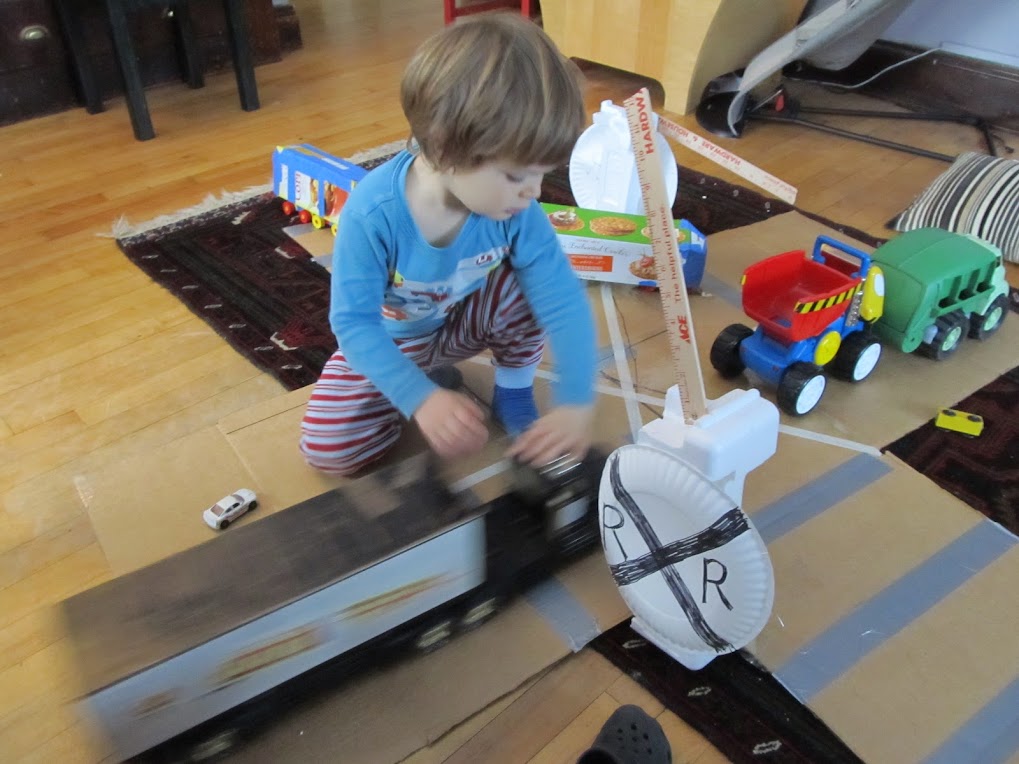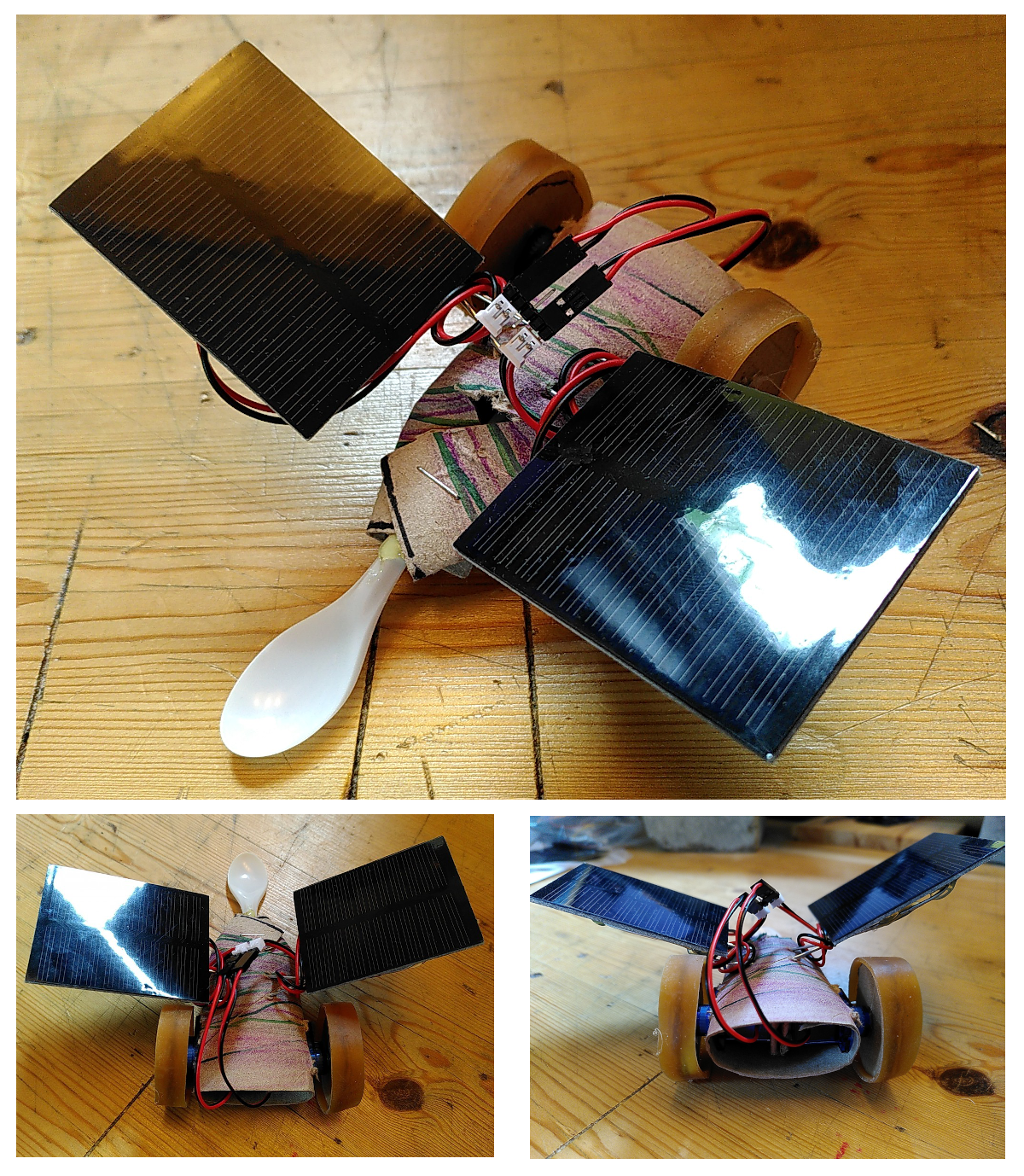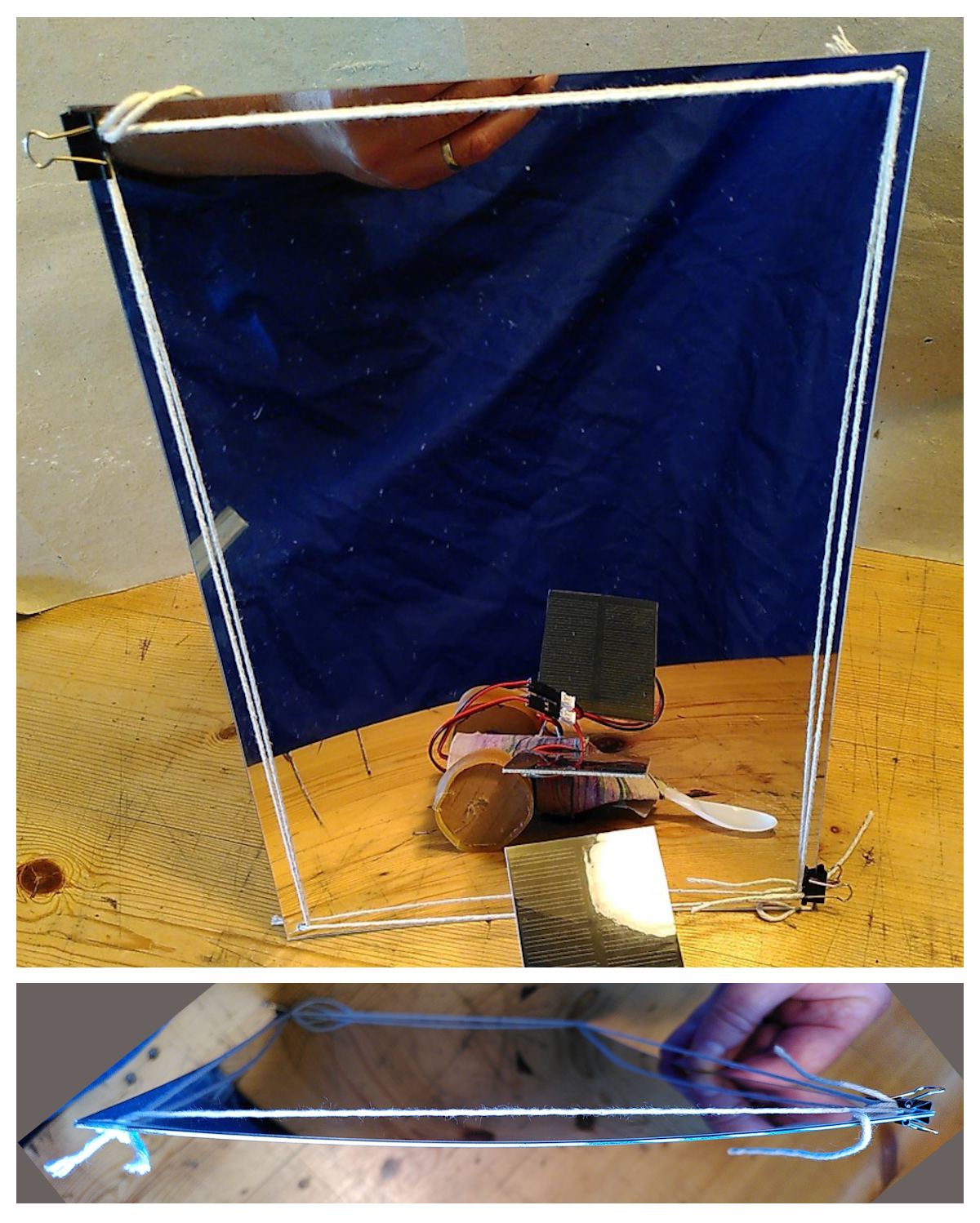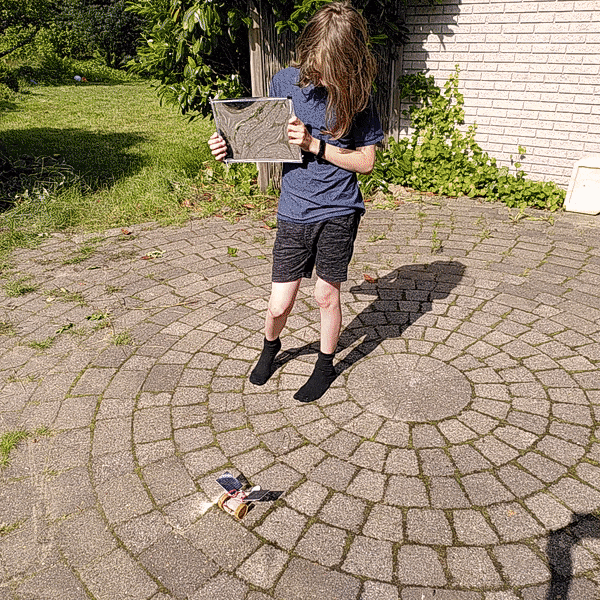# Playing with the Sun
Amos Blanton
First shared July 8, 2021
<img src =https://hedge.amosamos.net/uploads/upload_654388387d5b419dc56389aa678f273a.jpg width = 350 height = 340 style="border: 5px solid #FFF">
<img src =https://hedge.amosamos.net/uploads/upload_a9f901ee323bbd3e3432bb14b2ad5810.png width = 350 height = 340 style="border: 5px solid #FFF">
An alien anthropologist visiting earth today could see humanity's relationship to fossil fuels in the toys our children play with. As a little boy drives his toy truck around and fills it up at his pretend gas station, he re-enacts the world as it is now. For the child, toys are "objects to think with," tools that enable them to explore and to understand the complex relationships between the many different things in their world.
What if we made toys that enabled children to research, imagine, and perhaps even invent new relationships to energy through play?
Today there are very few toys that let children play with the generation and use of energy in a way that's open-ended. Fewer still invite them to propose new ideas and ask questions that adults don't already know the answers to. And yet most adults today don't seem to have a sophisticated or intuitive understanding of how energy is cultivated, or how it might be put to use more creatively and sustainably. Imagine, for a moment, that this isn't because they weren't taught enough about sustainability in school. Most adults have forgotten much of what they learned in school anyway. What if their lack of an intuitive understanding about energy is due to the inadequacy of their toys, their "tools to think with"?
If humanity is to learn to live sustainably in time to prevent catastrophic climate change, perhaps part of our strategy could be to create toys and play materials that enable us to explore new relationships with energy. For example, we know that with sustainable energy like wind and solar, the time between the generation of energy and the spending of it is usually measured in minutes and hours, and not millions of years, as with fossil fuels. Could toys help children and adults explore ways of using energy closer to its source in both space and time?
As we imagine different relationships to energy in which toys play a role, we can look to our history for inspiration. Until a few centuries ago, most goods were moved by sail. What is the relationship of the sailor to the wind? It might begin with the sailor as a child playing with a toy sailboat, exploring its different relationships to the breeze, and perhaps blowing on the sail. As it grows to maturity, the relationship becomes one of careful attention, of respect and deference to nature. There is a love for efficiency and elegance integrated so deeply with the art of sailing that it is often experienced aesthetically.
How can we create the conditions for play as a means to develop an intuitive understanding of energy, similar to the child learning to sail by playing with a boat? What sort of toys can we create that might enable children to develop a relationship with the sun that's closer to the relationship of the sailor to the wind?
## Bateson's Interlocked Horse and Grass
Gregory Bateson, an anthropologist credited with cofounding the disciplines of cybernetics and family therapy, spent a great deal of time thinking and writing about relationships. In this 1 minute long video clip from his daughter Nora Bateson's documentatry film titled *An Ecology of Mind*, Bateson describes the relationship between the horse and the grassy plain.
{%youtube Hvp0E2PEbFg %}
The relationship between horses and grass that has evolved over millenia has them "interlocked" to such a degree that it doesn't make sense to think of them in isolation. The fact that we do tend to think of horses without thinking about grass is perhaps more an artifact of our linguistic style of thinking than a true representation of the actual state of affairs. Is a horse really distinct from his environment? Perhaps in shorter timescales, but probably not in longer ones.
You could of course take a horse out of the field and put it in an empty white room and feed it synthetic grass pellets. But that would require a lot of work simulating the horse's natural environment, the grassy fields. As Bateson describes in the video, removing the horse from the relationship with the grass means that humans who want lawns have to take on the roles the horse normally handles. One must replace the horse's teeth with a lawnmower, and his digestive system with fertilizer.[^first] Otherwise the grass won't last more than a few years, as without the horse to keep it clear the open field will soon be replaced by bushes and trees.
Just as the horse co-evolved with grass over generations, each interlocked in a collaborative mutually beneficial relationship with the other, so has our relationship to energy co-evolved over the past few centuries with fossil fuels. If we want to change that relationship on the scale of years and generations, we need to consider how human beings first encounter and understand their relationship to energy in the light of Bateson's observations about horses and grass.
[^first]: The recent emergence of self-driving robotic lawnmowers in Europe illustrates Bateson's point. In their behavior they strongly resemble sheep as they trundle along in random directions, slowly munching away. Just as grass co-evolved with animals that eat it, now grass is co-evolving with us. Together we have manifested robots that behave a lot like grass's previous dance partners, the gramnivores.
## The Infinite River
Today when we need energy for something in our homes, we simply plug it in. This connects our device to a vast network of energy transmission and production, still mostly driven by fossil fuels. For the end user it is nothing if not consistent: Our device is given the same kind of power regardless of how sunny it is, or how hard the wind is blowing. The child (at least the privileged child, likely to ihherit power and privilege) learns that whenever you want power, you simply plug-in to the infinite river. There is no need to consider whether the sun is or isn't shining today, because the power comes from sunny days 200 million years ago.
The structure and norms of our power grid evolved out of our interlocked relationship with fossil fuels. There are absolutely no situations in nature in which an organism can take as much energy as it wants from sunlight stored 200 million years ago whenever it wants it and pay the bill in a month, regardless of local conditions. A tree cannot plug-in to a perfectly consistent power grid. It has to grow and store energy while the sun shines, and carefully husband what it has saved when the sun isn't shining. Its energy use is tightly coupled with its energy cultivation. Like all living things, much of its evolutionary creativity has developed within the constraint of its relationship to energy.
If we want to create the possibility for change in the relationship between people and energy, we need to enable both sides of the interlocked relationship - the horse and the grass - to explore different possibilities, and find new ways to relate. In this metaphor, people are horses and the designed objects that use and produce energy in the built environment are the grass. Because this will be a co-design process lasting generations, so it is important to look at how human beings first begin to understand relationships between the things in their world.
## The Role of Toys in Learning
A toy is a tool for exploring and understanding relationships through play.
The model 18 wheel semi-truck we found at a yard sale that my 4 year old son dubbed "Big-old long-old" inspired him to perform a deep throated rumble when it drove. It carried lots of sticks and sand in its trailer and then dropped them off at different locations in our yard. It wasn't fast and quick like his racecars, but its movements were heavy with meaning. It paused at intersections, and beeped when it backed into loading docks.

Many of the relationships trucks have - from the cargo they carry to the way they move - my son explored and understood by playing with his toy trucks. It was for him "an object to think with," as Seymour Papert described. But the thinking was primarily about how the truck fit into (and therefore maintained) the existing order of things. [^second]
What can we propose as an alternative, as a way for children to begin to explore and understand a different relationship to energy? To begin with, these alternative toys should enable playing with the generation of power from the immediate environment. Generation and storage of power are difficult to perceive, because they don't create a noticeable action or output like the expenditure of power does. A child can't see the energy they put into a battery until they use it to do some action, like drive a motor or light an LED. This distance between energy cultivation and energy expression makes the relationship abstract and difficult to grasp intuitively. So part of the research into developing toys to explore different relationships to energy will require some exploration into how to make the presence or absence of stored energy tangible. [^third]
Whatever process of harvesting energy is used, it will need to enable the child to explore, concretely, the toy's relationship to the source of power. A small solar panel driving a gear motor in full sunlight is an opportunity for the child to change the orientation of the panel and notice the resulting change in the sound and the speed of the motor. In this way, holding the panel perpendicular to the sun's rays to get the most power is learned as an experience first, which lays the intuitive foundation for becoming a concept later.
### The Solar Bug and the Mirror
The Solar Bug and the mirror is one example of a very simple toy that emerge from the set of goals and design constraints described in "Playing with the Sun."
The solar bug invites children to explore the relationship between the orientation of the sun's rays and the generation of solar energy. It has no energy storage, and its only electrical components are two solar panels and two gear motors [^fourth]. The left panel is connected to the right side motor. When sunlight is reflected from the mirror onto it, it drives the right wheel forward, turning the bug to the left. The same goes for the right panel, respectively.

The design of this toy is such that the energy generated by the solar panels in full sun without additional reflection from the mirrors should be inadequate or barely adequate to drive the motors. The child is given an A4 size piece of plastic mirror with holes drilled in the corners, which has been given a slight parabolic curve by adjustable tensioning strings held in place with binder clips. The mirror is adjustable in the short-term by bending it with their hands, and in the long term by adjusting the tension of the strings. At the start it should have about 8mm deflection along both axes as measured by the distance between the mirror and the center of the string, giving it a focal length of about 1 meter. The bright rectangle this reflection creates should enable the child to shine additional sunlight on one or both panels at the same time, which causes them to drive the motors.

The goal of the facilitator is to invite the child to explore the relationship between the sun, the mirror in their hand, and the solar panel, as immediately manifested in the behavior of the bug.

There is the potential for the child to develop their understanding of the relationship between the rays of the sun, her mirror, and the solar panel in a similar way that the child with a toy sailboat begins to understand the relationship of the wind to her sail. Orienting the mirror towards the sun will create a bright spot on the pavement that can be experimented with. For example, the children may notice that standing between the bug and the sun with the mirror doesn't create any reflection. The mirror is only effective within a range of angles between the the sun and a solar panel.
An important aspect of this activity is that it is very much subject to the weather. A passing cloud will have a noticeable effect, and broad cloud cover puts an end to the play[^fifth]. This, as Kris De Decker argues in his article about making his [online magazine's website solar powered](https://solar.lowtechmagazine.com/2018/09/how-to-build-a-lowtech-website.html), is itself an important idea to explore. When the solar panel that charges the battery driving the computer serving De Decker's website doesn't get enough sun, the battery runs out and the website goes offline. Just as when the wind didn't blow on windmills in the 18th century, the millers stopped the work of milling and did something else. De Decker argues that a sustainable relationship to energy will require a similar acceptance of inconsistencies in the supply, because consistency is [much more costly](https://www.lowtechmagazine.com/2017/09/how-to-run-modern-society-on-solar-and-wind-powe.html) than accepting some downtime and variation.
It's not an accident that the "Solar Bug" utilizes the metaphor of an animal and not a machine. An insect has to harvest energy throughout its life. When it has an excess it can be quick, and when energy is scarce it will move slowly out of the necessity to conserve. Our centers of manufacturing could be designed along similar lines: When there is available solar or wind energy, energy use can be high and production can move quickly. And when the wind doesn't blow and the sun doesn't shine, production must slow or stop. From the standpoint of how we relate to energy today, this may seem like a radical idea. But it is the way every other living thing on our planet behaves.
## Strategies for Collective Design Research at Scale
Given the increasingly dire state of the climate crisis and failure of existing institutions to meaningfully address it, there is a need for broad engagement with the design goals and constraints described in Playing with the Sun.
Let's imagine working within the set of design goals and values described in this document with educator researchers working in different institutions: the school, a library, and a science museum. What sorts of strategies might we use to leverage the collective creativity of many different educators and children in the role of research practitioners, across many different contexts? For example - if an interesting idea emerges out of the explorations of a child in the library, how does this idea get recorded, reflected on, and shared with the other research practitioners involved in the project at the school, or at the makerspace?
A different way to frame this problem is: How much constraint is needed to keep different sites and communities doing this research on the same page, such that they can meaningfully support one another's and the whole group's shared inquiry?
<!---
### The Library: Designing toys for Solarpunk Futures
Solarpunk is a recent genre of science fiction that "imagines futures that address environmental concerns with varying degrees of optimism." [^sixth] In solarpunk fiction, humanity's relationship to energy production and use has changed so that the many environmental crises we face today, climate change among them, are or are in the process of being resolved. So Solarpunk as a genre represents a collective imagining of new relationships to energy production and use, and to one another.
Let's imagine librarians as designers using the existing genre of Solarpunk fiction as a kind of collection of ready-made speculative design documents. What sort of toys would the children in these imaginary futures play with, and how do they reflect the character's sustainable relationship to energy production and use? For example, let's imagine a story in which the power used by the protagonists come from wind. One can begin to imagine and design, based on the aesthetics in the story, the toys that the children of the protagonists might play with that let them play with the wind.
What sorts of distributed design process would we use to imagine and invent these toys today?
One strategy would be to engage in a long term collective design process involving children and designers in an an informal and creative civic space - like the library. Returning to the metaphor of the horse and the grassy plain, this would allow us to experiment on both sides of the interlocked relationship. The children are invited to "play" with the different toys that emerge from the design process. And the designers would be able to observe and interact with them in order to refine their designs and imagine new possibilities for toys that explore relationships to energy. In this way, we can create optimal conditions for the exploratory evolution of both sides of the interlocked relationship.
-->
<!---
End Draft, notes follow:
To Do:
Rewrite, reframe (or unpack) addiction metaphor, strident statements about inefficiency of power grid. Choose battles. Reframe as questions - what if we looked at it this way? If we did then that etc. would follow....
Andreas notes -
Likes toy - something to co-explore with Olafur
Issues with Introduction.
- Intro speaks from a position of activisim that's not explained / justified / unpacked
- "The relationship of an addict" - an activist
- is it necessary to what you want to do?
- is it adding to the design process?
It doesn't open up for exploration - stands as a postulate rather than something documented.
- Addict metaphor doesn't give
- Basically you can't defend / unpack that here.
If it were productive, you'd go back to it
- it's not important, bc/ you don't.
Olympic point of view - that you odn't have to make the argument.
Frame as a question: Are we interlocked with oil?
In research you need to allow space for the world to surprise you.
What question does the river metaphor raise in the activity...
Activity doesn't have to
When I say that energy transmission network is ineffeicient - how is that backedup?
That's choosing a battle I don't need to.
---
possible alternative title or framing:
What is the pedagogy of solarpunk?
http://www.re-des.org/a-solarpunk-manifesto/
### The toy truck gets its power and relevance, in the child's eyes, from the real full-sized truck. So how could we establish a relationship between the toys we make for exploring the sun, and with real full sized solar installations? Or is there is medium ground, where we design solar powered utliities that lots of people have? Or installations in parks that lots of people encounter?
I like the idea of the child have a toy that is an analog of a bigger version which they can encounter in a public space. This could have potential for Olafur's work as well.
* Build section: Describe modularity, and invite them to engage with it during the build - exploring different components.
* Diversity of outcomes here serves to communicate to each learner the range of possiblities developed by the whole group.
* Enable connections across scales: It's easy to connect the toy truck to the real truck: they are very similar across size. How then to connect the toy to the actual generation of power? The analog would be the small toy solar panel to the one on the house's roof. But the action of both are difficult to perceive.
-->
[^second]: By reifiying the existing order of things, the existence of so many toy cars and trucks provides incalculable marketing value for fossil fuel industries and the industries that derive from them. Young children have so much to absorb that much of their experience must be accepted uncritically as "the way it is."
[^third]:When a child drinks a caffeinated drink or gets 'hyper' they feel energized, and this is easily perceived by anyone nearby. Perhaps this is a relatable quality that could be designed into toys that have collected and stored a lot of energy.
[^fourth]: [DC Motor in Micro Servo body](https://www.adafruit.com/product/2941), [Seeed studio .5W solar panel](https://www.mouser.dk/ProductDetail/713-313070004), header, toilet paper tube, plastic spoon, rubber band, cardboard.
[^fifth]: I should say, increasing cloud cover *probably* puts an end to the play. If there are 10 kids with 10 mirrors and the sky becomes overcast, if they all shine their mirrors on the same single bug can they get it to move?
[^sixth]: Wikipedia, https://en.wikipedia.org/wiki/Solarpunk.